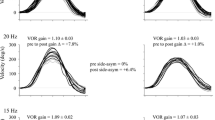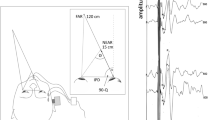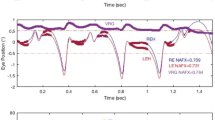Abstract
The aim of this study was to determine whether vergence-mediated changes in the axis of eye rotation in the human vestibulo-ocular reflex (VOR) would obey Listing's Law (normally associated with saccadic eye movements) independent of the initial eye position. We devised a paradigm for disassociating the saccadic velocity axis from eye position by presenting near and far targets that were centered with respect to one eye. We measured binocular 3-dimensional eye movements using search coils in ten normal subjects and 3-dimensional linear head acceleration using Optotrak in seven normal subjects. The stimuli consisted of passive, unpredictable, pitch head rotations with peak acceleration of ~2,000°/s2 and amplitude of ~20°. During the pitch head rotation, each subject fixated straight ahead with one eye, whereas the other eye was adducted 4° during far viewing (94 cm) and 25° during near viewing (15 cm). Our data showed expected compensatory pitch rotations in both eyes, and a vergence-mediated horizontal rotation only in the adducting eye. In addition, during near viewing we observed torsional eye rotations not only in the adducting eye but also in the eye looking straight ahead. In the straight-ahead eye, the change in torsional eye velocity between near and far viewing, which began ~40 ms after the start of head rotation, was 10±6°/s (mean ± SD). This change in torsional eye velocity resulted in a 2.4±1.5° axis tilt toward Listing's plane in that eye. In the adducting eye, the change in torsional eye velocity between near and far viewing was 16±6°/s (mean ± SD) and resulted in a 4.1±1.4° axis tilt. The torsional eye velocities were conjugate and both eyes partially obeyed Listing's Law. The axis of eye rotation tilted in the direction of the line of sight by approximately one-third of the angle between the line of sight and a line orthogonal to Listing's plane. This tilt was higher than predicted by the one-quarter rule. The translational acceleration component of the pitch head rotation measured 0.5 g and may have contributed to the increased torsional component observed during near viewing. Our data show that vergence-mediated eye movements obey a VOR/Listing's Law compromise strategy independent of the initial eye position.






Similar content being viewed by others
References
Angelaki DE (1998) Three-dimensional organization of otolith-ocular reflexes in rhesus monkeys. III. Responses to translation. J Neurophysiol 80:680–695
Aw ST, Haslwanter T, Halmagyi GM, Curthoys IS, Yavor RA, Todd MJ (1996a) Three-dimensional vector analysis of the human vestibulo ocular reflex in response to high-acceleration head rotations. I. Responses in normal subjects. J Neurophysiol 76:4009–4020
Aw ST, Halmagyi GM, Haslwanter T, Curthoys IS, Yavor RA, Todd MJ (1996b) Three-dimensional vector analysis of the human vestibulo ocular reflex in response to high-acceleration head rotations. II. Responses in subjects with unilateral vestibular loss and selective semicircular canal occlusion. J Neurophysiol 76:4021–4030
Bronstein AM, Hood JD (1986) The cervico-ocular reflex in normal subjects and patients with absent vestibular function. Brain Res 373:399–408
Bruno P, Van den Berg AV (1997) Relative orientation of primary positions of the two eyes. Vision Res 37:935–947
Busettini C, Miles FA, Schwarz U, Carl JR (1994) Human ocular responses to translation of the observer and of the scene: dependence on viewing distance. Exp Brain Res 100:484–494
Carl JR, Gellman RS (1987) Human smooth pursuit: stimulus-dependent responses. J Neurophysiol 57:1446–1463
Clark RA, Miller JM, Demer JL (2000) Three-dimensional location of human rectus pulleys by path inflections in secondary gaze positions. Invest Ophthalmol Vis Sci 41:3787–3797
Collewijn H, Van der Steen J, Ferman L, Jansen TC (1985) Human ocular counterroll: assessment of static and dynamic properties from electromagnetic scleral coil recordings. Exp Brain Res 59:185–196
Crawford JD, Vilis T (1991) Axes of eye rotation and Listing's law during rotations of the head. J Neurophysiol 65:407–423
Cremer PD, Halmagyi GM, Aw ST, Curthoys IS, McGarvie LA, Todd MJ, Black RA, Hannigan IP (1998) Semicircular canal plane head impulses detect absent function of individual semicircular canals. Brain 121:699–716
Demer JL, Miller JM, Poukens V, Vinters HV, Glasgow BJ (1995) Evidence for fibromuscular pulleys of the recti extraocular muscles. Invest Ophthalmol Vis Sci 36:1125–1136
Fetter M, Tweed D, Hermann W, Wohland-Braun B, Koenig E (1992) The influence of head position and head reorientation on the axis of eye rotation and the vestibular time constant during postrotatory nystagmus. Exp Brain Res 91:121–128
Halmagyi GM, Curthoys IS, Cremer PD, Henderson CJ, Todd MJ, Staples MJ, D'Cruz DM (1990) The human horizontal vestibulo-ocular reflex in response to high-acceleration stimulation before and after unilateral vestibular neurectomy. Exp Brain Res 81:479–490
Haslwanter T (1995) Mathematics of three-dimensional eye rotations. Vision Res 35:1727–1739
Hepp K (1990) On Listing's law. Commun Math Phys 132:285–295
Lasker DM, Ramat S, Carey JP, Minor LB (2002) Vergence-mediated modulation of the human horizontal angular VOR provides evidence of pathway-specific changes in VOR dynamics. Ann NY Acad Sci 956:324–337
Merfeld DM, Teiwes W, Clarke AH, Scherer H, Young LR (1996) The dynamic contributions of the otolith organs to human ocular torsion. Exp Brain Res 110:315–321
Migliaccio AA, Todd MJ (1999) Real-time rotation vectors. Australas Phys Eng Sci Med 22:73–80
Misslisch H, Tweed D, Fetter M, Sievering D, Koenig E (1994) Rotational Kinematics of the human vestibulo-ocular reflex. III Listing's Law. J Neurophysiol 72: 2490–2502
Mok D, Ro A, Cadera W, Crawford JD, Vilis T (1992) Rotation of Listing's Plane during vergence. Vision Res 32:2055–2064
Paige GD (1989) The influence of target distance on eye movement responses during vertical linear motion. Exp Brain Res77:585–593
Paige GD, Tomko DL (1991a) Eye movement responses to linear head motion in the squirrel monkey. I. Basic characteristics. J Neurophysiol 65:1170–1182
Paige GD, Tomko DL (1991b) Eye movement responses to linear head motion in the squirrel monkey. II. Visual-vestibular interactions and kinematic considerations. J Neurophysiol 65:1183–1196
Porrill J, Ivins JP, Frisby JP (1999) The variation of torsion with vergence and elevation. Vision Res 39:3934–3950
Press WH, Flannery BP, Teukolsky SA, Vetterling WT (1988) Numerical recipes in C. Cambridge University Press, Cambridge, UK
Robinson DA (1963) A method of measuring eye movement using a scleral search coil in a magnetic field. IEEE Trans Biomed Eng 10:137–145
Schwarz U, Miles FA (1991) Ocular responses to translation and their dependence on viewing distance. I. Motion of the observer. J Neurophysiol 66:851–864
Somani RA, Desouza JF, Tweed D, Vilis T (1998) Visual test of Listing's law during vergence. Vision Res 38:911–923
Tweed D (1997) Visual-motor optimization in binocular control. Vision Res 37:1939–1951
Tweed D, Vilis T (1987) Implications of rotational kinematics for the oculomotor system in three dimensions. J Neurophysiol 58:832–849
Tweed D, Vilis T (1990) Geometric relations of eye position and velocity vectors during saccades. Vision Res 30:111–127
Tweed D, Cadera W, Vilis T (1990) Computing three-dimensional eye position quaternions and eye velocity from search coil signals. Vision Res 30:97–110
Tychsen L, Lisberger SG (1986) Visual motion processing for the initiation of smooth-pursuit eye movements in humans. J Neurophysiol 56:953–968
Van Gisbergen JAM, Minken AWH (1994) Conjugate and disconjugate contributions to bifoveal fixations studied from a 3-D perspective. In: Delgado-Garcia JM, Godaux E, Vidal PP (eds) Information processing underlying gaze control. Pergamon, Oxford
Van Rijn LJ, Van den Berg AV (1993) Binocular eye orientations during fixations: Listing's Law extended to include eye vergence. Vision Res 33:691–708
Vibert N, MacDougall HG, Waele C de, Gilchrist DP, Burgess AM, Sidis A, Migliaccio A, Curthoys IS, Vidal PP (2001) Variability in the control of head movements in seated humans: a link with whiplash injuries? J Physiol (Lond) 532:851–868
Acknowledgements
This work was supported by an Australian Post-Graduate Award Scholarship (Dr. Migliaccio), Royal Prince Alfred Hospital Department of Neurology Trustees, and by NIH Grant R01 DC 05040 (Dr. Minor)
Author information
Authors and Affiliations
Corresponding author
Rights and permissions
About this article
Cite this article
Migliaccio, A.A., Cremer, P.D., Aw, S.T. et al. Vergence-mediated changes in the axis of eye rotation during the human vestibulo-ocular reflex can occur independent of eye position. Exp Brain Res 151, 238–248 (2003). https://doi.org/10.1007/s00221-003-1447-z
Received:
Accepted:
Published:
Issue Date:
DOI: https://doi.org/10.1007/s00221-003-1447-z




